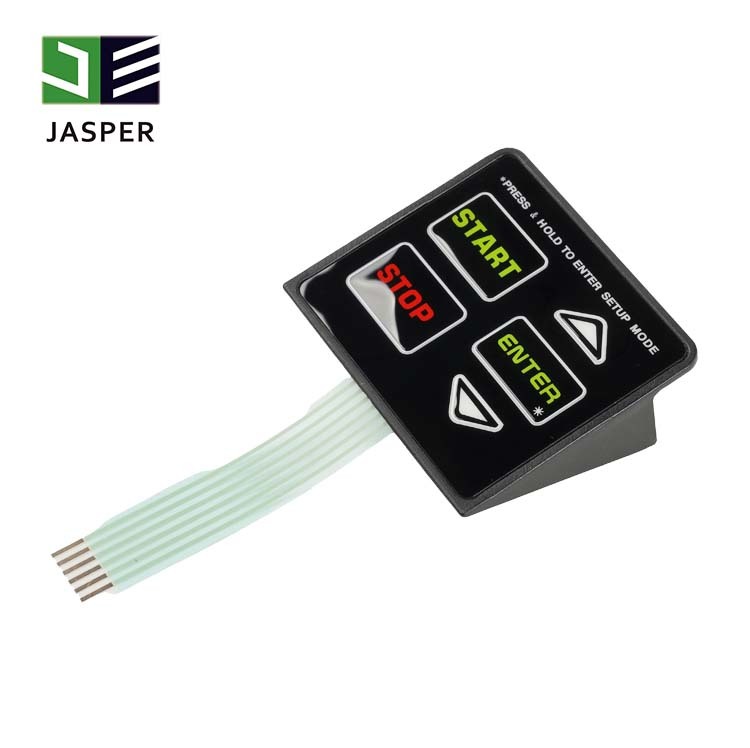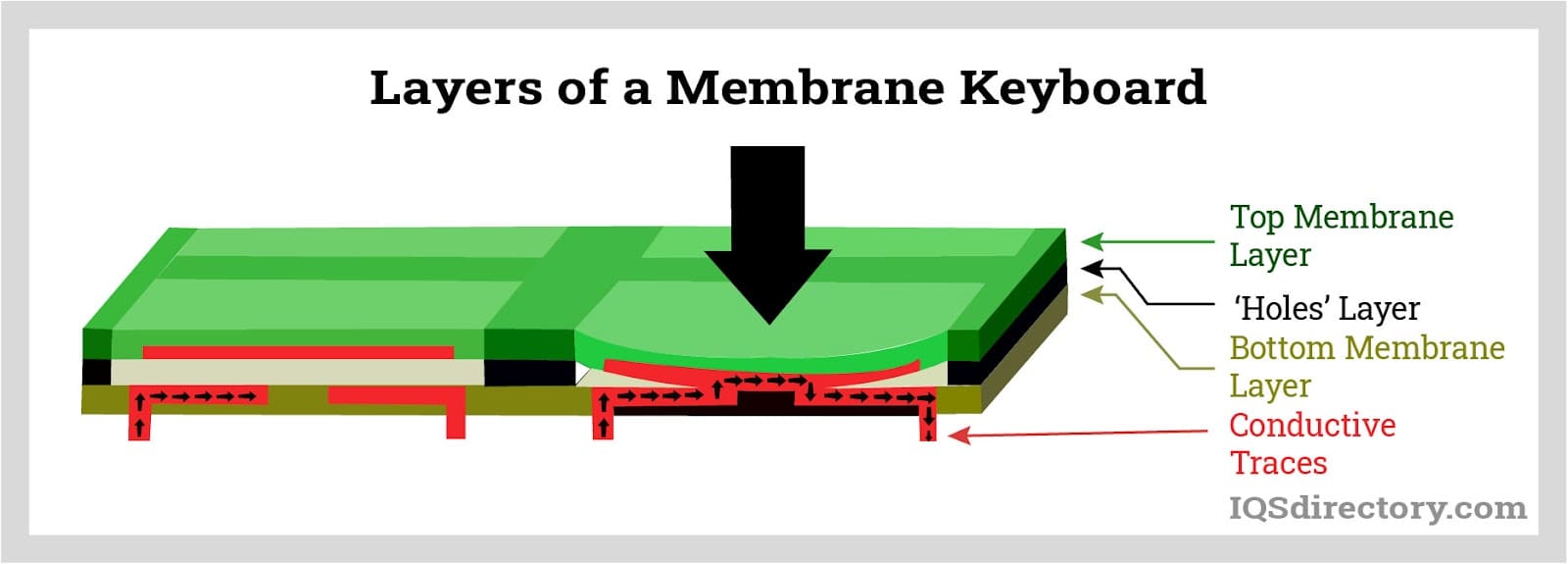Designing intuitive user interfaces with membrane switch
All Concerning Membrane layer Switch: A Comprehensive Guide for Beginners
Membrane layer switches are crucial parts in modern-day electronics, supplying a distinct interface for user interaction - membrane switch. Their layered building and construction, including overlays and conductive traces, gives performance and durability. Unlike typical mechanical buttons, membrane layer switches provide a streamlined style and adjustable alternatives. Comprehending their vital features and advantages can transform product design. The complexities of their application and style considerations require additional expedition.
What Is a Membrane Change?
A membrane layer button is a sort of electric button that is composed of a versatile membrane layer layered over a published motherboard. This design enables a portable and streamlined user interface, typically made use of in numerous digital tools. Membrane layer buttons are commonly located in consumer appliances, medical equipment, and commercial machinery because of their sturdiness and resistance to ecological factors.The building and construction normally consists of several layers, such as graphic overlays and adhesive backing, which give responsive responses and secure the wiring beneath. The operation of a membrane layer button is launched when pressure is put on the surface area, completing an electrical circuit.These buttons are valued for their versatility, making it possible for personalized styles and printed graphics that cater to specific customer interfaces. Their inconspicuous nature decreases room demands, making them optimal for applications where typical buttons might not fit. On the whole, membrane switches supply a practical and aesthetic solution for contemporary electronic devices.
Secret Parts of Membrane Switches Over
Membrane layer switches make up several essential components that add to their performance and efficiency. The top layer, called the overlay, provides the individual interface and is frequently printed with graphics or signs. Underneath the overlay exists a spacer layer, which divides the conductive components and stops unintentional activation. The following crucial part is the graphic layer, which improves appearances and ensures the resilience of the design.Conductive traces, commonly made from products like silver or carbon, are published on the circuit layer. When stress is applied to the overlay, these traces enter contact, finishing the circuit. Furthermore, a backing layer uses architectural support and can be made from materials such as polyester or polycarbonate. Together, these elements create a trusted, easy to use user interface ideal for various applications, from family devices to commercial equipment. Recognizing these components is essential for anybody thinking about membrane switch technology.
How Membrane Switches Over Job
Recognizing just how membrane switches feature is necessary for valuing their widespread use in various devices. A membrane layer button operates with a series of layers, including a graphic overlay, spacer, and a circuit layer. When stress is related to the overlay, it compresses the spacer layer, enabling the circuit layer to make call and finish an electrical circuit. This action sends out a signal to the device, prompting a response, such as transforming on a light or turning on a function.Membrane switches can be made with different functions, including tactile feedback, backlighting, and personalized graphics, improving individual interaction. Their construction enables a covered style, securing the internal parts from dust, moisture, and contaminants. This durability makes them ideal for diverse applications, from consumer electronic devices to industrial tools. Generally, the simplicity and effectiveness of membrane layer switches add to their popularity in modern-day technology.
Benefits of Membrane Switches Mechanical Buttons
While mechanical buttons have long been a staple in several tools, membrane switches over offer unique advantages that make them significantly appealing. One considerable advantage is their slim profile, enabling more portable designs and greater flexibility in item growth. Additionally, membrane layer changes attribute an uniform surface, which improves aesthetic charm and streamlines cleaning, making them appropriate for environments where hygiene is critical.Another advantage is their resistance to dirt and moisture. Unlike mechanical buttons, which can be endangered by environmental elements, membrane layer switches supply a covered interface that safeguards versus contaminants - membrane switch. Membrane switches usually have a longer life expectancy due to fewer relocating parts, resulting in boosted longevity and reliability.Cost-effectiveness is additionally a significant advantage, as membrane buttons can be produced in mass with reduced manufacturing costs. These variables incorporate to position membrane switches as a sensible choice to typical mechanical choices in various applications
Usual Applications of Membrane Switches Over
Membrane layer switches are widely utilized in various industries, particularly in consumer electronic devices and industrial control panels. In customer devices, they provide a smooth, straightforward interface, while in commercial settings, they improve durability and capability. Understanding these applications highlights the adaptability and functionality of membrane buttons in modern technology.
Customer Electronic Devices Tools
As consumer electronic devices continue to progress, membrane switches have come to be a prominent selection for a selection of gadgets as a result of their adaptability and sleek design. These switches are look here commonly found in smartphones, tablets, and remotes, where room is limited and aesthetics issue. Their low profile and personalized styles enable suppliers to create user-friendly interfaces that boost the general individual experience. Furthermore, membrane buttons are often used in appliances such as microwaves and coffee manufacturers, supplying intuitive control choices while standing up to dampness and dust. The toughness and dependability of membrane changes make them appropriate for everyday customer items, making sure long life and consistent performance. Generally, their assimilation in customer electronic devices reflects a blend of capability and modern-day design.
Industrial Control Panels
The applications of membrane layer changes expand past consumer electronic devices, locating significant use in commercial control board. These buttons are preferred for their durability and resistance to severe environments, making them ideal for making and procedure control setups. They provide a trusted user interface for operators to control machinery, display processes, and readjust settings. Membrane layer switches can be customized to fit certain operational demands, including attributes like backlighting and responsive comments, improving individual experience. Their low-profile layout permits integration into numerous equipment, while their ability to hold up against spills, dirt, and extreme temperature levels assurances durability. Overall, membrane switches add to secure and reliable procedure in industrial applications, showing their convenience and effectiveness sought after settings.
Considerations for Creating Membrane Layer Switches
When designing membrane layer buttons, selecting the best products is important to assure sturdiness and performance. In addition, recognizing layer setup methods can greatly impact the button's performance and individual experience. These factors to consider play a crucial function in developing efficient and reputable membrane switch layouts.
Material Selection Relevance
Material option plays a crucial role in the style and performance of membrane buttons. The chosen products directly influence the button's resilience, tactile feedback, and total visual. Trick factors to consider include the substratum, which have to supply architectural integrity while enabling flexibility, and the visuals overlay, which needs to be resistant to use and ecological variables. Conductive products need to guarantee reputable electrical efficiency, while adhesives should offer solid bonding without jeopardizing the button's operation. In addition, compatibility with making procedures and end-user atmospheres is crucial; materials should hold up against differing temperature levels, moisture levels, and chemical direct exposure. Inevitably, proper product selection not just boosts the membrane switch's efficiency but additionally adds to its durability and individual satisfaction, making it a critical aspect of the layout procedure.

Layer Setup Techniques

Frequently Asked Questions
How Much Time Do Membrane Changes Generally Last?
Membrane switches typically have a life expectancy of 1 to 5 million cycles, relying on use and environmental conditions. Aspects such as layout quality and operating regularity greatly affect their durability and overall efficiency long life.

Can Membrane Layer Switches Be Custom-made for Certain Styles?
Membrane switches can certainly be tailored to suit specific layouts, permitting diverse shapes, shades, and functionalities. This flexibility enables manufacturers to tailor these switches to satisfy unique aesthetic and operational requirements efficiently.
What Products Are Utilized in Membrane Layer Switch Construction?
Membrane layer switches are commonly built making use of products such as polyester, polycarbonate, and sticky layers. These materials supply flexibility, resistance, and resilience to ecological variables, ensuring the buttons a knockout post work efficiently in different applications and conditions.
Are Membrane Switches Resistant or water-proof to Wetness?
Membrane layer buttons can be developed to be moisture-resistant, utilizing specialized materials and finishes. Their waterproof abilities depend on construction quality and certain applications, making it essential to evaluate requirements for optimal performance in various environments.
How Are Membrane Layer Switches Over Fixed if Damaged?
Fixing broken membrane layer switches over typically includes changing the influenced layer or circuit. Professionals might also apply conductive glue or use specialized repair work kits, guaranteeing capability is recovered without full substitute of the entire button assembly. Unlike traditional mechanical buttons, membrane buttons present company website a smooth layout and personalized options. A membrane layer switch is a kind of electric button that consists of a versatile membrane layer layered over a printed circuit board. The procedure of a membrane switch is started when stress is used to the surface area, completing an electric circuit.These switches are valued for their convenience, enabling personalized styles and published graphics that cater to specific individual interfaces. While mechanical switches have actually long been a staple in numerous tools, membrane switches over deal unique benefits that make them progressively appealing. Membrane layer switches commonly have a longer life expectancy due to fewer moving parts, resulting in boosted toughness and reliability.Cost-effectiveness is also a significant advantage, as membrane layer switches can be produced in bulk with reduced manufacturing prices.